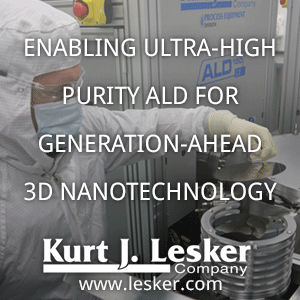Wednesday, December 9, 2020
MSS Corp Low temp ALD the solution for analyzing extreme ultraviolet photoresist
ALD to take over more and more as CVD and spin-on processes no longer are viable for 3D NAND
- Gapfill dielectrics
- Conformal liners
- Patterning spacers and masks
- Hermetic encapsulation
- Etch stop layers
- Optical films
Monday, December 7, 2020
Chipmetrics Oy commercialises 3D test chip for ALD developed by VTT
High-quality HfS2 2D-material by ALD at 100°C
A high-quality 2D-material by #ALDep at 100°C! Yuanyuan's very systematic and complete study of the well-behaved surface chemistry performed in collaboration with 7 other groups @FAU_Germany is published in Adv. Mater. Interfaces:https://t.co/Y9g1RPsdTx pic.twitter.com/dW8bG0BHAD
— CTFM lab (@CtfmLab) December 6, 2020
Thursday, December 3, 2020
AtomicLimits launch picture database for Atomic Level Processing
PICOSUN® Sprinter launch disrupting fast batch ALD on 300 mm wafers at EFDS ALD for Industry 2020
Picosun launches PicoOS™, a unified control software for PICOSUN® ALD modules and clusters
Wednesday, December 2, 2020
The global semiconductor market is projected to grow by 8.4 percent in 2021 according to WSTS Forecast
Saturday, November 28, 2020
SAMCO launch ALD system for MEMS and SiC and GaN power devices
Ferroelectric Memory GmbH (FMC) Raises $20 M to Accelerate Next-Generation Memory for AI, IoT, Edge Computing, and Data Center Applications
Intel remains in the lead in 2020 semiconductor sales
Applied Materials will regain its No. 1 ranking in the semiconductor equipment market in 2020 from ASML
- Atomic Layer Deposition
- MOCVD
- Furnace
- Dielectric Etch
- Spray Processing
- Dielectric Etch (including ALE)
- Wet Stations
1. Move in to top 3 spot in ALD2. Take number 2 spot in Furnace business
Tuesday, November 24, 2020
Beneq ALD Stories Episode 4 - The story about the BALD Engineering Blog
Thursday, November 19, 2020
Intel to present 3D stacked Nanoribbon Transistors for Continued Moore’s Law Scaling at IEDM 2020
Paper Information (IEDM 2020) : LINK
·
(1) shows
the evolution of transistor architectures from planar, to FinFETs, to
nanoribbons and to a 3D CMOS architecture.
·
(2) (a)
shows a 3D schematic diagram of stacked CMOS Si nanoribbon transistors with
NMOS on PMOS, (b) describes the process flow; (c) is a TEM image of a stacked
multiple-nanoribbon CMOS inverter with a 40-nm gate length and inner (Vss)
and outer (Vcc) contacts, a common gate input (VIN) and
an inverter output node (VOUT); while (d) is a TEM image of two Si
NMOS nanoribbons atop 3 Si PMOS nanoribbons.
·
(3) (a)
is a process flow of the vertically stacked dual S/D EPI process, while (b)
shows P-EPI selectively grown on the bottom three nanoribbons, (c) shows N-EPI
selectively grown on the top two nanoribbons, and (d) features TEM and EDS
images showing selective N-EPI and P-EPI growth on the stacked nanoribbon
transistors.
·
(4)
(a) is a process flow of the vertically stacked dual metal gate process; (b) is
a TEM image and (c, d) are EDS images of the dual metal gate with N-WFM (WFM =
work function metal) on the top two nanoribbons and P-WFM on the bottom three
nanoribbons.
Wednesday, November 18, 2020
Japanese researchers enable high thru put conformal CVD for SiC on Silicon wafer integration
Porous Membranes as Sacrificial Layers Enabling Conformal Chemical Vapor Deposition Involving Multiple Film-Forming Species
Kohei Shima, Yuichi Funato, Noboru Sato, Yasuyuki Fukushima, Takeshi Momose, and Yukihiro Shimogaki
ACS Appl. Mater. Interfaces 2020, 12, 45, 51016–51025
Publication Date:October 30, 2020
https://doi.org/10.1021/acsami.0c14069
Tuesday, November 17, 2020
Roll-To-Roll ALD to Thermally Stabilizing NCM Cathodes for Lithium Ion Batteries
- The capacity retention of TiO2-coated porous electrodes is substantially improved compared to that of the pristine cathode material for high-temperature cycling.
- Electrochemical impedance spectroscopy confirms that the ALD-TiO2 coating suppresses the undesired side reactions initiated at the electrode/electrolyte interface, reduces charge transfer resistance, and ultimately facilitates the Li+ transport through the composite cathode nanostructure.
- The NCM cathode material enables high-temperature operation (>55 °C) with enhanced specific capacity, superior rate capability, excellent cyclability, and high coulombic efficiency within a wide potential window (3.0–4.35 V).
- The R2R ALD technique developed in this work paves the way for large-scale fabrication of ceramic-coated cathode sheets with a production rate reaching 2.4 m min–1 for a continuous coating operation.
New ALD Valve by TLX
AICHE 2020: Machine Learning-Based Modeling and Operation of PEALD of HfO2 Thin-Films
Forge Nano and Argonne improve yield in propylene manufacturing by ALD coating
- deep dehydrogenation
- hydrogenolysis
- cracking
- polymerization
- coke formation.
Zheng Lu, Ryon W. Tracy, M. Leigh Abrams, Natalie L. Nicholls, Paul T. Barger, Tao Li, Peter C. Stair,
Arrelaine A. Dameron, Christopher P. Nicholas, and Christopher L. Marshall
ACS Catal. 2020, 10, XXX, 13957–13967
Publication Date:November 16, 2020
https://doi.org/10.1021/acscatal.0c03391



%20(1).png)




















